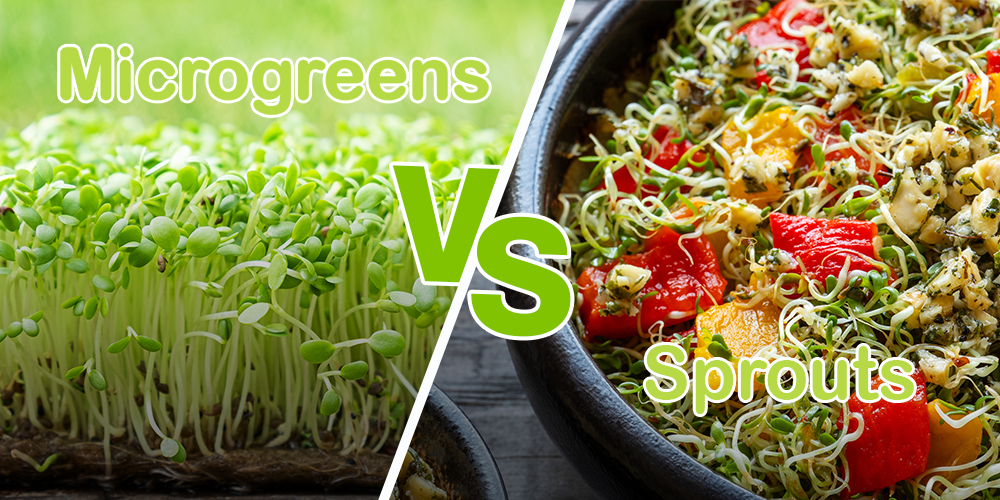Sprouts vs. Microgreens: What's the Difference?
If you’ve ever wondered how sprouts and microgreens differ, you’re not alone! Both are young plants bursting with nutrients, but they’re grown and consumed in distinct ways. Think of them as siblings—sprouts are the younger, carefree sibling, while microgreens are the slightly older, more refined one. Let’s break it down!
Sprouts: The Tiny Burst of Life
What Are They?
Learn More
What Are They?
Sprouts are the earliest stage of plant growth. They’re seeds that have just started to germinate, growing tiny roots and shoots. You eat the whole thing—seed, root, stem, and all!
How Are They Grown?
Learn More
How Are They Grown?
Sprouts are grown entirely in water, with no soil or sunlight required. It’s as simple as soaking the seeds, rinsing them twice daily, and watching them transform in a jar or sprouter. They’re ready to eat in just 2–7 days—talk about instant gratification!
What Do They Taste Like?
Learn More
What Do They Taste Like?
Sprouts are mild, crisp, and refreshing. Each variety has its own subtle flavor. For instance:
⦁ Alfalfa sprouts are delicate and grassy.
⦁ Broccoli sprouts have a slight peppery kick.
⦁ Mung bean sprouts are crunchy and nutty.
Nutritional Highlights
Learn More
Nutritional Highlights
Sprouts are nutritional dynamos, packed with enzymes, proteins, and antioxidants. Broccoli sprouts, for example, are famous for their sulforaphane content, which supports detoxification and fights inflammation.
How to Use Them
Learn More
How to Use Them
Sprouts are a raw superstar! Toss them in salads, pile them onto sandwiches, or use them as a crunchy topping for wraps and grain bowls.
Microgreens: The Gourmet Cousin
What Are They?
Learn More
What Are They?
Microgreens are the next stage of growth after sprouts. They’re harvested a little later, after the first "true leaves" (known as cotyledons) appear. Unlike sprouts, you eat only the tender stems and leaves—roots are left behind. Microgreens are more typically used by chefs as garnishes too as they have more flavor and more color than sprouts generally.
How Are They Grown?
Learn More
How Are They Grown?
Microgreens grow in soil or a hydroponic medium, and they need light to develop their vibrant colors and distinct flavors. They take a bit longer to grow—7 to 21 days—but the payoff is worth it. They look like miniature versions of full-grown greens, adding a gourmet touch to any dish.
What Do They Taste Like?
Learn More
What Do They Taste Like?
Microgreens are flavor-packed! Their tastes are more intense and varied compared to sprouts. Examples include:
⦁ Sunflower microgreens: nutty and slightly sweet.
⦁ Radish microgreens: spicy and bold.
⦁ Basil microgreens: aromatic and herbaceous.
Nutritional Highlights
Learn More
Nutritional Highlights
Microgreens are nutrient powerhouses, often containing 4–40 times the vitamins and minerals of their mature counterparts. For example, red cabbage microgreens have been found to pack six times more vitamin C than the mature plant!
How to Use Them
Learn More
How to Use Them
Microgreens are as versatile as they are beautiful. Use them as a garnish for soups, add them to smoothies, toss them into salads, or sprinkle them over avocado toast.
Key Differences at a Glance
| Feature | Sprouts | Microgreens |
|---|---|---|
| Growth Medium | Grown in water | Grown in soil or hydroponic medium |
| Harvest Time | 2–7 days | 7–21 days |
| Parts Consumed | Entire sprout (seed, root, stem, shoot) | Stems and leaves only |
| Light Requirement | None | Indirect sunlight |
| Flavor | Mild, refreshing | Intense, varied |
| Uses | Raw in salads, sandwiches | Gourmet garnish, smoothies, salads |
Which One Should You Grow?
- Go for sprouts: if you’re after a quick, easy way to get fresh greens with minimal effort. They’re perfect for busy beginners or anyone short on time.
- Choose microgreens: if you’re looking to elevate your meals with vibrant flavors, colors, and gourmet appeal. They take a bit more effort, but the rewards are stunning!
Both sprouts and microgreens are nutrient-packed, delicious, and easy to grow. Whether you go for the simplicity of sprouts or the elegance of microgreens, your body (and your taste buds) will thank you! 🌱






